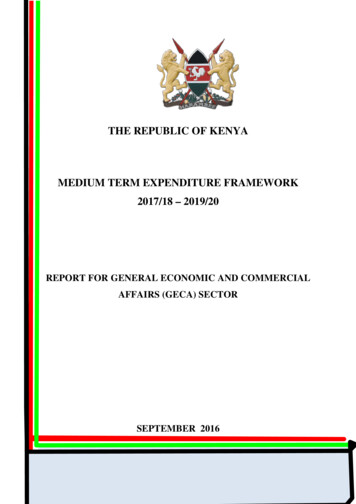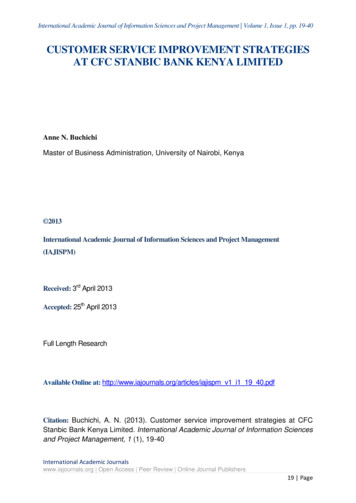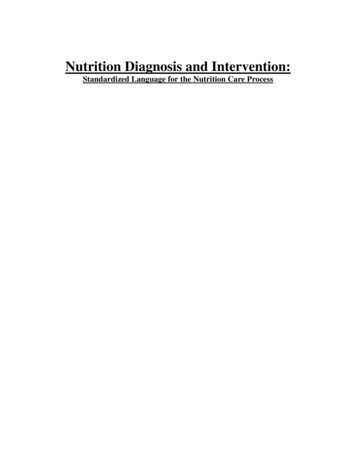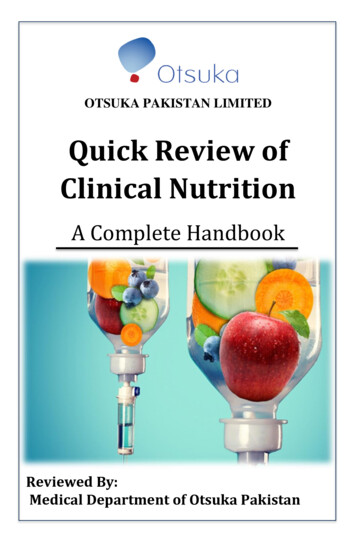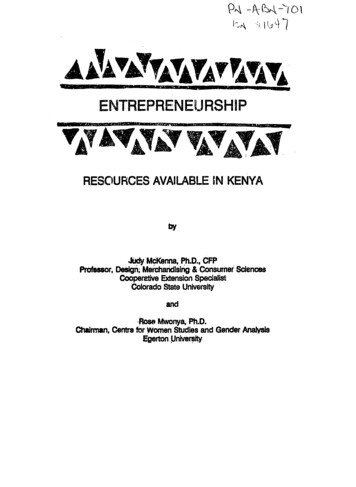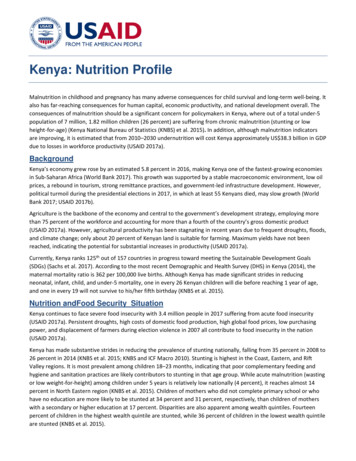
Transcription
Kenya: Nutrition ProfileMalnutrition in childhood and pregnancy has many adverse consequences for child survival and long-term well-being. Italso has far-reaching consequences for human capital, economic productivity, and national development overall. Theconsequences of malnutrition should be a significant concern for policymakers in Kenya, where out of a total under-5population of 7 million, 1.82 million children (26 percent) are suffering from chronic malnutrition (stunting or lowheight-for-age) (Kenya National Bureau of Statistics (KNBS) et al. 2015). In addition, although malnutrition indicatorsare improving, it is estimated that from 2010–2030 undernutrition will cost Kenya approximately US 38.3 billion in GDPdue to losses in workforce productivity (USAID 2017a).BackgroundKenya’s economy grew rose by an estimated 5.8 percent in 2016, making Kenya one of the fastest-growing economiesin Sub-Saharan Africa (World Bank 2017). This growth was supported by a stable macroeconomic environment, low oilprices, a rebound in tourism, strong remittance practices, and government-led infrastructure development. However,political turmoil during the presidential elections in 2017, in which at least 55 Kenyans died, may slow growth (WorldBank 2017; USAID 2017b).Agriculture is the backbone of the economy and central to the government’s development strategy, employing morethan 75 percent of the workforce and accounting for more than a fourth of the country’s gross domestic product(USAID 2017a). However, agricultural productivity has been stagnating in recent years due to frequent droughts, floods,and climate change; only about 20 percent of Kenyan land is suitable for farming. Maximum yields have not beenreached, indicating the potential for substantial increases in productivity (USAID 2017a).Currently, Kenya ranks 125th out of 157 countries in progress toward meeting the Sustainable Development Goals(SDGs) (Sachs et al. 2017). According to the most recent Demographic and Health Survey (DHS) in Kenya (2014), thematernal mortality ratio is 362 per 100,000 live births. Although Kenya has made significant strides in reducingneonatal, infant, child, and under-5 mortality, one in every 26 Kenyan children will die before reaching 1 year of age,and one in every 19 will not survive to his/her fifth birthday (KNBS et al. 2015).Nutrition and Food Security SituationKenya continues to face severe food insecurity with 3.4 million people in 2017 suffering from acute food insecurity(USAID 2017a). Persistent droughts, high costs of domestic food production, high global food prices, low purchasingpower, and displacement of farmers during election violence in 2007 all contribute to food insecurity in the nation(USAID 2017a).Kenya has made substantive strides in reducing the prevalence of stunting nationally, falling from 35 percent in 2008 to26 percent in 2014 (KNBS et al. 2015; KNBS and ICF Macro 2010). Stunting is highest in the Coast, Eastern, and RiftValley regions. It is most prevalent among children 18–23 months, indicating that poor complementary feeding andhygiene and sanitation practices are likely contributors to stunting in that age group. While acute malnutrition (wastingor low weight-for-height) among children under 5 years is relatively low nationally (4 percent), it reaches almost 14percent in North Eastern region (KNBS et al. 2015). Children of mothers who did not complete primary school or whohave no education are more likely to be stunted at 34 percent and 31 percent, respectively, than children of motherswith a secondary or higher education at 17 percent. Disparities are also apparent among wealth quintiles. Fourteenpercent of children in the highest wealth quintile are stunted, while 36 percent of children in the lowest wealth quintileare stunted (KNBS et al. 2015).
Inadequate infant and young child feeding practices also contribute to high rates of malnutrition in the country.Although exclusive breastfeeding practices have increased dramatically, from 32 percent in 2008 to 61 percent in 2014,only 42 percent of infants 4–5 months of age are still exclusively breastfed and only 62 percent of mothers initiatebreastfeeding within an hour of birth (KNBS et al. 2015; KNBS and ICF Macro 2010). In addition, complementary feedingpractices are poor in Kenya, as only 22 percent of breastfed children 6–23 months received a minimum acceptable diet(KNBS et al. 2015). Vitamin A deficiency is relatively low at 9 percent in children under 5 years. However, only 35percent of children 6–23 months consumed vitamin A-rich foods and 16 percent consumed iron-rich foods in the pastday (KNBS et al. 2015; MOH 2011). Maternal and child anemia are widely prevalent in Kenya, with 36 percent ofchildren under 5 years and 42 percent of pregnant women suffering from anemia (KNBS et al. 2015; National MalariaControl Programme (NMCP Kenya et al. 2016). Adolescent girls 15–19 years in Kenya are the most malnourished groupamong women of reproductive age; 17 percent have a body mass index 18.5, compared to 6 percent of women 40–49years of age (KNBS et al. 2015). Although undernutrition is still an issue in Kenya, overweight and obesity are alsobecoming a concern, with 33 percent of women overweight or obese (KNBS et al. 2015).Kenya has one of the world’s highest rates of population growth (USAID 2017a). The population has tripled in the past35 years, straining the country’s resources and leaving young people, especially women, particularly vulnerable topoverty and malnutrition (KNBS et al. 2015). Although the total fertility rate has reduced in the past 20 years (from 5.4in 1993 to 3.7 in 2015), the adolescent fertility rate increased between the 2008–09 DHS and the 2014 DHS, from 36 to40 percent (Central Bureau of Statistics (CBS) [Kenya], et al. 2004; KNBS and ICF Macro 2010; NMCP Kenya et al. 2016).The high prevalence of adolescent pregnancy has serious consequences because, relative to older mothers, adolescentgirls are more likely to be malnourished and have a low birth weight baby who is more likely to become malnourished,and be at increased risk of illness and death than those born to older mothers. The risk of stunting is 33 percent higheramong first-born children of girls under 18 years in Sub-Saharan Africa, and as such, early motherhood is a key driver ofmalnutrition (Fink et al. 2014).Kenya Nutrition Data (DHS 2008–2009 and 2014, MIS 2015, and NNS 2011)Population 2016 (UNICEF 2017)Population under 5 years of age (0–59 months) 2016 (UNICEF 2017)Prevalence of stunting among children under 5 years (0–59 months)Prevalence of underweight among children under 5 years (0–59 months)Prevalence of wasting among children under 5 years (0–59 months)Prevalence of low birth weight (less than 2.5 kg) (of children whose birth weights areknown)Prevalence of anemia among children 6–59 monthsPrevalence of anemia among women of reproductive age (15–49 years) (nonpregnant)Prevalence of thinness among women of reproductive age (15–49 years) (BMI lessthan 18.5 kg/m2)Prevalence of children 0–5 months exclusively breastfedPrevalence of children 4–5 months exclusively breastfedPrevalence of early initiation of breastfeeding (i.e. put to the breast within 1 hour ofbirth)Prevalence of children who receive a pre-lacteal feedPrevalence of breastfed children 6–23 months receiving minimum acceptable diet1248.5 million7 millionDHS 2008–200935%16%7%DHS 201426%11%4%6%8%46%36% 122% 2NA12%9%32%13%61%42%58%62%42%24%16%22%Data are from the 2015 Malaria Indicator Survey, not the 2014 DHS.Data are from the 2011 National Nutrition Survey, not the 2008–2009 DHS.2Updated February 2018
Prevalence of overweight among children under 5 years (0–59 months)Prevalence of overweight among women of reproductive age (15–49 years)Coverage of iron for pregnant women (for at least 90 days)Coverage of vitamin A supplements for children (6–59 months, in the last 6 months)Percentage of children 6–59 months living in households with iodized saltNA: Not Available5%25%3%30%98%4%33%8%72%100%Global and Regional Commitment to Nutrition and AgricultureKenya has made the following global and regional commitments to nutrition and agriculture:Year of Commitment2012NameCommitting to Child Survival: APromise Renewed Campaign2012Scaling Up Nutrition (SUN)Movement2010Comprehensive Africa AgricultureDevelopment Programme (CAADP)Compact3DescriptionKenya pledged to reduce under-5mortality to 20 or fewer deaths per1,000 live births by 2035 by reducingthe leading preventable causes ofchild mortality, includingundernutrition (A Promise Renewed2017).In 2012, Kenya joined Scaling UpNutrition (SUN), a global movementthat unites national leaders, civilsociety, bilateral and multilateralorganizations, donors, businesses,and researchers in a collective effortto improve nutrition. Priorities for2017–2018 include advocating forthe finalization and dissemination ofkey bills in parliament (e.g., Foodand Nutrition Security Bill and theBreastfeeding Bill), support for thedissemination and implementationof the Health Act 2017, and roll-outof the nutrition financial trackingtool at the national and countylevels, among others (SUN 2017).The European Union is the SUNdonor convener.The government has demonstratedcommitment to agriculturaldevelopment, signing a CAADPCompact in 2010. CAADP is anAfrica-led program bringing togethergovernments and diversestakeholders to reduce hunger andpoverty and promote economicgrowth in African countries throughagricultural development. In thesame year, the governmentlaunched a new Agricultural SectorDevelopment Strategy, which isaligned with the CAADP.Updated February 2018
National Nutrition Policies/Legislation, Strategies, and InitiativesKenya’s commitment to improving nutrition is established in Vision 2030, the country’s development blueprint, and isaligned to the government’s broader Medium-Term Development Plan as well as the following documents: National Nutrition Action Plan (2012)National Food and Nutrition Security Policy (2011)National Comprehensive School Health Policy (2007)The Breast Milk Substitutes (Regulation and Control) Act No.34 of 2012Kenya National Strategy for the Prevention and Control of Non-Communicable Disease (2015–2020)United Nations Development Assistance Framework for Kenya (2014–2018)National School Health Strategy Implementation Plan (2011)Child Survival and Development Strategy (2008)Food Security and Nutrition Strategy (2008)The Government of Kenya approved a National Nutrition Action Plan (NNAP) in November 2012. As this comes to anend in 2017, the process of reviewing its successes, best practices, challenges, and lessons learned has been completedand will inform the development of the new NNAP. Kenya plans to roll out 11 evidence-based High Impact NutritionInterventions and has set the following nutrition targets for between 2010 and 2030: reduce severe and moderatestunting by one-third, eliminate iodine deficiency, and reduce anemia by 30 percent. The overall impact expected is a30 percent reduction in child mortality and an increase in GDP of up to 3 percent, if implemented to scale (USAID 2011).A Nutrition Interagency Coordinating Committee serves as the multi-stakeholder and multi-agency platform tocoordinate nutrition programs. High-level coordination structures—the National Food Security and Nutrition SteeringCommittee (NFSNSC) and the National Food and Nutrition Security Secretariat (NFNSS)—have been established in theOffice of the President. Kenya’s ongoing process of decentralization ensures that nutrition is also prioritized within thecountry’s 47 counties, each of which is developing a nutrition implementation plan. These efforts to addressmalnutrition at both the national and county levels are contributing to Kenya being one of the few countries in theworld that is on track to meet the World Health Assembly 2025 nutrition targets (UNICEF 2016).USAID Programs: Accelerating Progress in NutritionAs of January 2018, the following USAID programs with a focus on nutrition were active in Kenya. The U.S. Governmentselected Kenya as one of 12 Feed the Future target countries for focused investment under the new U.S. GovernmentGlobal Food Security Strategy.Selected Projects and Programs Incorporating Nutrition in KenyaNameDatesDescriptionFeed the FutureOngoingFeed the Future, the U.S. government’s global hunger and food securityinitiative, has an overarching mission to: facilitate inclusive agriculture sectorgrowth through value chains, increase resilience and economic growth, andimprove the nutritional status of rural farming families, especially women andchildren under 5 years of age. Feed the Future currently targets semi-arid andhigh-rainfall areas, both of which have great potential for increasing agriculturalproductivity, and also encompass the highest concentrations of malnourishedchildren, female-headed households, and rural poor.Rather than a standalone flagship nutrition project in Kenya, Feed the Futuresupports the nutrition components within projects which aim to improve theavailability of food, income, and women’s empowerment. Nutrition messagingthrough Social and Behavior Change Communication (SBCC) promotes behavior4Updated February 2018
change across agriculture, WASH, and health activities. Since nutrition-sensitiveagriculture activities alone do not automatically translate into nutritional gains,the projects layer with maternal and child health services supported by theOffice of Health as well as other nutrition-specific interventions. In addition,they layer nutrition-sensitive agriculture activities with WASH activities tocontribute to improvements in nutritional status and support behavior changesrelated to the use of clean water, sanitation, and other practices to support asafe and clean environment.Food for PeaceOngoingUSAID’s Office of Food for Peace (FFP) targets food-insecure Kenyans in arid andsemi-arid areas and refugees living in the Dadaab and Kakuma camps. FFPprograms provide relief and build resilience to chronic shocks through directfood distribution, supplementary feeding, maternal and child health andnutrition, food-for-assets, cash-for-assets, and therapeutic feeding activities inKenya. In Fiscal Year 2017, FFP is providing support to the World FoodProgramme (WFP) for contingency planning for possible violence anddisplacement associated with the Kenyan general elections, as well assupplementary nutritious foods for all children under 5 years and for pregnantand lactating women in the counties with the highest levels of acutemalnutrition (USAID 2017b).Livestock MarketSystems (LMS)Program2017–2022USAID Kenya Cropand Dairy MarketSystemsDevelopmentActivityAfya Halisi2017–2022LMS aims to strengthen people’s resilience to shocks and stresses and to reducethe prevalence and depth of poverty, household hunger, and chronic undernutrition.The program aims to do this by strengthening institutions, market systems,governance, and human capital.The purpose of the USAID Kenya Crop and Dairy Market Systems DevelopmentActivity is to support inclusive and sustainable agriculturally-led economicgrowth, strengthened resilience among people and systems, and a well-nourishedpopulation, especially women and children.2017–2022Afya Halisi seeks to increase key nutrition practices and utilization of focusedmaternal, neonatal, child, and adolescent health services; reproductive healthand family planning services; and WASH services in Kitui and Western regions.Afya Uzazi2016–2021Afya Uzazi seeks to increase adoption of healthy maternal, neonatal, child, andadolescent health behaviors; reproductive health behaviors; WASH; and nutritionbehaviors in Nakuru and Baringo counties.Afya Timiza2016–2021Afya Timiza seeks to accelerate scale-up of high-impact maternal, neonatal, child,adolescent, and reproductive health interventions, including priority nutritionand WASH interventions in Turkana and Samburu counties.Kenya integratedWater andSanitationProgram2015–2020KIWASH aims to: improve health outcomes through the provision of sustainableWASH; promote the use of small-scale irrigation kits for use in kitchen gardensto increase the intake of micronutrients at the household level; and provideagricultural information, improved technologies, and nutrition messaging to therural poor to improve nutrition and potentially increase incomes through salesof excess produce.2015–2020Kenya RAPID seeks to help communities have increased access to sustainableWASH services and improved rangeland management. The program seeks to(KIWASH)Kenya ResilientArid Lands5Updated February 2018
Partnership forIntegratedDevelopment(Kenya RAPID)promote the use of safe water, sanitation facilities, and good hygiene to improvenutritional outcomes by addressing both the immediate and underlying causes ofmalnutrition, as well as to promote point-of-use water treatment and safestorage options at the household level in all intervention communities. Theprogram also plans to promote kitchen gardens at household level and provideeducation on key nutrients and food diversification strategies.ISPP contributes to the reduction of rural poverty and food and nutritioninsecurity of smallholders by improving smallholder farmers’ agriculturalproductive capacity, economic potential, and nutritional outcomes.IncreasingSmallholderProductivity andProfitability (ISPP)ProjectMaternal ChildSurvival Program(MCSP)2016–20192014–2019MCSP seeks to increase the capacity of county health management teams inKenya to deliver high-impact interventions including nutrition.Nutrition HealthProgram plus(NHPplus)2015–2019NHPplus seeks to increase access to and demand for quality nutrition services,improve food and nutrition security, and provide commodity managementsupport. NHPplus buys and distributes fortified, blended food and ready-to-usetherapeutic food to address severe acute malnutrition (FHI 360 2017).Afya Pwani2016–2019Afya Pwani seeks to increase access to and utilization of focused maternal,neonatal, and child health services; reproductive health and family planningservices; and WASH services in Kilifi county.Kenya AgriculturalValue ChainEnterprises(KAVES)2013–2018KAVES seeks to increase the productivity and incomes of rural households andother actors along the dairy, horticulture, and staple crops value chains, therebyenhancing food security and improving nutrition.Accelerated ValueChainDevelopmentProgram (AVCD)2015–2018AVCD seeks to apply technologies and innovations widely for selected valuechains to competitively and sustainably increase productivity; and to contributeto the Feed the Future project goals of inclusive agricultural growth andimproved nutrition and food security in the country by: Afya Jijini62015–2018Increasing the productivity and utilization of crops to improve access toand diversity of food among the targeted beneficiaries.Undertaking specific activities to improve the quality of food at thehousehold and market levels by improving the storage, processing, andcooking techniques used by households.Afya Jijini seeks to increase access to and utilization of focused maternal,neonatal, child, and adolescent health services; reproductive health and familyplanning services; WASH; and nutrition services in Nairobi county.Updated February 2018
ReferencesA Promise Renewed. 2017. “Kenya.” Available at: tral Bureau of Statistics (CBS) [Kenya], Ministry of Health (MOH) [Kenya] and ORC Macro. 2004. Kenya Demographic andHealth Survey 2003: Key Findings. Calverton, Maryland, USA: CBS, MOH, and ORC Macro.FHI 360. 2017. “Project: Nutrition and Health Program Plus (NHPplus) in Kenya.” Available ealth-program-plus-nhpplus-kenya.Fink, G., Sudfeld, C.R., Danaei, G., Ezzati, M., and Fawzi, W.W. 2014. “Scaling-Up Access to Family Planning May ImproveLinear Growth and Child Development in Low and Middle-Income Countries.” PLoS ONE 9(7): e102391. Doi:10.1371/journal.pone.0102391.Kenya National Bureau of Statistics, Ministry of Health, National AIDS Control Council, Kenya Medical Research Institute,National Council for Population and Development and ICF International. 2015. Kenya Demographic and Health Survey 2014.Nairobi, Kenya and Rockville, MD: KNBS and The DHS Program/ICF International.KNBS and ICF Macro. 2010. Kenya Demographic and Health Survey 2008-09. Calverton, Maryland: KNBS and ICF Macro.Ministry of Health (MOH). 2011. The Kenya National Micronutrient Survey 2011. Available nt%20Survey%202011.pdfNational Malaria Control Programme (NMCP) Kenya, Kenya National Bureau of Statistics (KNBS) and ICF International. 2016.Kenya Malaria Indicator Survey 2015. Nairobi, Kenya: NMCP, KNBS, and ICF International.Sachs, J., Schmidt-Traub, G., Kroll, C., Durand-Delacre, D., and Teksoz, K. 2017. SDG Index and Dashboards Report 2017. NewYork, NY: Bertelsmann Stiftung and Sustainable Development Solutions Network (SDSN).SUN. 2017. Kenya SUN Movement Annual Progress Report 2017. Available at: rt-2017.pdf.UNICEF. 2016. Kenya, 14 June 2016: First Lady launches the 2016 Global Nutrition Report in Nairobi. Available at:https://www.unicef.org/esaro/5440 ken2016 2016-nutrition-report.html.UNICEF. 2017. The State of the World’s Children 2017. Available at: https://www.unicef.org/sowc/USAID. 2011. Kenya: FY 2011–2015 Multi-Year Strategy. Available pdfUSAID. 2017a. “Country Profile: Kenya.” Available at: http://www.feedthefuture.gov/country/kenyaUSAID. 2017b. “Horn Of Africa - Complex Emergency Fact Sheet #1, Fiscal Year (FY) 2018.” Available ents/1866/hoa ce fs01 11-28-2017.pdfWorld Bank. 2017. “Kenya Country Overview.” Available at: 7Updated February 2018
Kenya National Strategy for the Prevention and Control of Non-Communicable Disease (2015-2020) United Nations Development Assistance Framework for Kenya (2014-2018) . The Government of Kenya approved a National Nutrition Action Plan (NNAP) in November 2012. As this comes to an end in 2017, the process of reviewing its successes .

